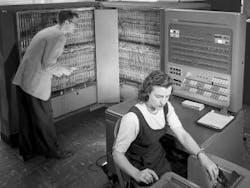The US electric grid is having its smart phone moment. Will the federal government get in the way? That’s the worry of clean energy groups that are arming themselves with research on grid modernization.
Electronic data processing machine used for making computations by NASA in the 1950s. Credit: NASA
The groups are responding to an April 14 memo where U.S. Energy Secretary Rick Perry questions policy that encourages renewable and distributed energy. He suggests that a decline in use of ‘baseload’ coal-fired plants could lead to electric grid instability. The Department of Energy is preparing a report on the issue with release expected shortly.
While federal agencies typically seek industry comment when contemplating big shifts in energy policy, Perry did not, saying that the DOE is “uniquely qualified for the task.”
Concerned about the lack of outside input, the Advanced Energy Economy (AEE), the American Wind Energy Association (AWEA) and the Natural Resources Defense Council (NRDC) recently commissioned a response from two often-cited energy research firms, the Brattle Group and Analysis Group. The reports look at the role baseload plants — nuclear and coal — play on the new grid.
The bottom line? Renewables are not jeopardizing reliability and the very idea of ‘baseload’ — power plants that run almost all the time — may be antiquated, given today’s mix of flexible, software-driven power resources.
Coal, mainframe computers and buggy whips
To those on the forefront of grid modernization, what Perry is suggesting is analogous to swapping out today’s palm-size smart phones for a return to room-size mainframe computers of 50 years ago that did far less.
“The perceived need for ‘baseload’ resources is in many cases counterproductive to meeting America’s electricity system needs and public policy objectives at the lowest cost. As policy efforts seek to reduce the environmental impact of generating power, coupling variable wind or solar energy with a more flexible resource mix often does the job far more economically,” says John Moore, director of the Sustainable FERC Project housed within NRDC.
The debate goes beyond the old battle line between renewable energy and fossil fuels and highlights the value of of nimble power sources, like microgrids and distributed energy resources.
Flexibility is the key on the new grid, according to the report, “Advancing Past ‘Baseload’ to a Flexible Grid,” prepared by the Brattle Group and issued by NRDC.
It’s expensive to turn most big coal-fired and nuclear plants on and off, so they cannot be responsive to minute-by-minute changes in price and conditions on the grid, as newer technologies can.
There was a time when bigger was better on the grid, when large nuclear and coal-fired plants offered economies of scale, says the NRDC report. But several factors have changed grid economics, among them the falling price of both natural gas and renewable energy (fuels that are often used in microgrids), environmental rules and declining use of electricity in the U.S.
Grid modernization makes ‘baseload’ a dated concept
These factors are leading to the retirement of older coal and nuclear plants, based on their economic performance. Those still operating are experiencing steep revenue losses in some parts of the country during times of day when power prices drop, says the report. They are unable to compete against other resources, particularly solar and natural gas.
The NRDC cites the “2016 State of the Market” report by PJM, the largest grid operator in North America, as showing that “new entrant natural gas-fired combined cycle plants, combustion turbine plants, and solar are economical, but that new coal and nuclear plants are not.”
The environmental organization does not advocate doing away with centralized resources, but does suggest that it’s outdated to describe them as ‘baseload’ – the underlying platform that ensures the flow of electricity. Instead, grid modernization is creating a carefully managed mix of various resources – each best during different times – that makes for reliable and low-cost electric supply.
Software intelligence manages these complex electric systems for maximum efficiency and reliability. For example, NRDC notes that a 2017 study by the ISO/RTO Council found benefit in use of monitoring equipment and data analysis.
“This is particularly important when customers own or use distributed generation that traditionally are not visible to wholesale market administrators. The report indicates that technologies that improve situational awareness at all levels of the bulk power system, and those that collect data on distributed resources will be more valuable going forward,” says NRDC.
Meanwhile, the AEE/AWEA report, prepared by Analysis Group, notes that today’s diversification of resources is leading to lower wholesale market costs for electricity. And lower costs are leading to disruption.
Reliability again?
It’s not unusual for industries at the losing end of such trends to claim that change may jeopardize electric reliability, says AEE/AWEA’s report, “Electricity Markets, Reliability and the Evolving U.S. Power System.” The report cited similar reliability scares evoked when the industry restructured two decades ago to allow for retail competition, as well when various emissions rules were put in place over the years for sulfur dioxide, mercury and cross-state pollution. Now it’s distributed energy and renewables.
In truth, the North American Electric Reliability Corporation – the agency charged by the federal government with monitoring grid reliability – has found that today’s changing mix of resources is not degrading the grid, says the report.
“Not only have there been no serious reliability effects to date, but also numerous studies on renewable integration and coal retirements have concluded that regions within the U.S. can continue to add larger percentages of generation coming from natural gas and renewable resources without anticipated reliability concerns,” says the AEE/AWEA report. “In fact, in regions and/or at times when natural gas supply is constrained, renewable generation plays a significant positive reliability role by reducing the amount of gas needed to meet demand, making additional gas supplies available.”
New technology will inevitably usurp some of today’s generation resources. That appears to be what’s happening with coal as North American pursues grid modernization.
New England may offer an example of what’s to come. Following the retirement of several coal-fired plants, the six-state region now uses coal for only two percent of its generation. How has that impacted electric reliability? Apparently not at all, according to a quote by Gordon van Welie included in the AEE/AWEA report. “…coal is now largely irrelevant in New England…and everyone else says we need coal to maintain resilience? That just doesn’t compute for me.”
What’s your take on the DOE’s call for an inquiry into coal’s decline and elecrtric reliabilty. Let us know by posting on our LinkedIn Group, Distributed Energy Resources.







